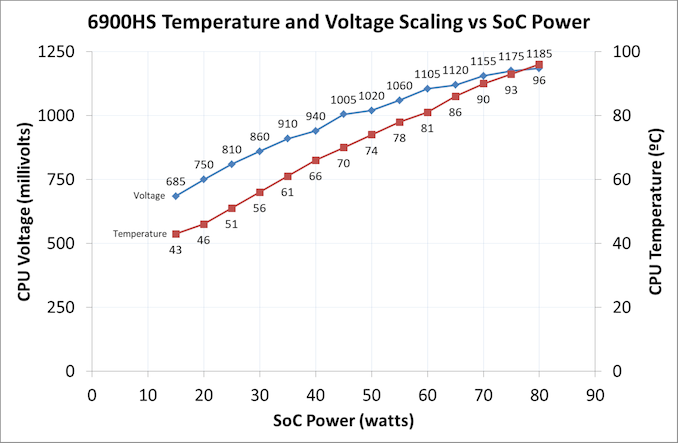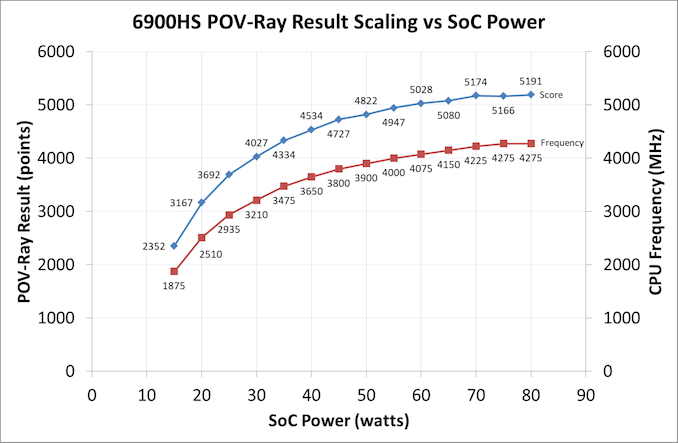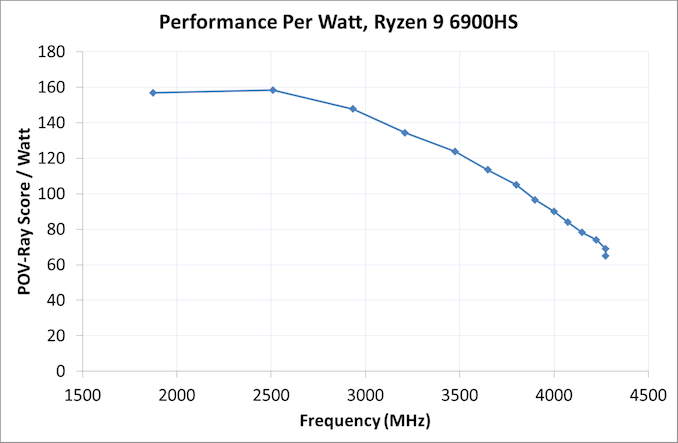AMD's Ryzen 9 6900HS Rembrandt Benchmarked: Zen3+ Power and Performance Scaling
by Dr. Ian Cutress on March 1, 2022 9:30 AM ESTPerformance Per Watt
With the ASUS Zephyrus G14, it comes with some fancy ASUS software called the Armo(u)ry Crate. Inside is the usual array of options for a modern laptop when it comes to performance profiles, fans, special RGB effects and lighting, information about voltages, frequencies, fan speeds, fan profiles, and all that jazz. However inside the software there is also an interface that allows the user to cap how much APU/SoC power can be put through the processor or the whole platform.
With this option, we took advantage of the fact that the after we select a given SoC wattage, the system will automatically migrate to the required voltage and frequency under load while only ever going up to the power limits - or as much as the system would be allowed to. Using this tool, we ran a spectrum of performance data against power options to see how the POV-Ray benchmark would scale, as it is one of the benchmarks that drives core use very high and very hard.
In this first graph, we monitor how the CPU voltage increases by raising the power, as well as the at-load temperature of the processor. The voltage increments start off around the 60-65 mW per 5W of SoC power, eventually becoming 15-25 W due to the way that voltage and power scales. The temperature was a very constant rise, showing 96ºC with the full 80 W selected.
Now if we transition this to the benchmark results, as we plot this with the all-core frequency as well:
These two lines follow a similar pattern, as the score doesn't increase if the frequency doesn't increase. The biggest jumps are in the 15-35W mark, which is where most modern processors are the most efficient. However as the power is added in, the processor moves away from that ideal efficiency point, and going from 50 W to 80 W is a 60% power increase for only +375 MHz and only +7.7% increased score in the benchmark.
We can pivot this data into something a bit more familiar:
Here we can see the voltage required for all-core frequencies and how the voltage scales up. With all this data, we can actually do a performance per watt graph for Rembrandt:
In this graph we're plotting Score per watt against Frequency, and it showcases that beyond 2.5 GHz, the Rembrandt CPU design becomes less efficient. Most modern processors end up being most efficient around this frequency, so it isn't perhaps all that surprising.
Now all of this is also subject to binning - not only are chips binned by the designation (6900HS vs 6800H for example), but also within an individual SKU, there will be better bins than others. We see this in some mobile processors that can have 10+ bins with different voltage/frequency characteristics, but all still called the same, because they perform at a shared guaranteed minimum. With smartphones, this testing is a lot easier, as that voltage/frequency table is often part of the hardware mechanism. But for notebooks and desktops, we're often at the mercy of the motherboard manufacturer or OEM, who can use their own settings, overriding anything that Intel or AMD suggest. Hopefully in the future we will get more control and be able to determine what is manufacturer based and what is motherboard based.















92 Comments
View All Comments
ingwe - Tuesday, March 1, 2022 - link
While I understand not looking at battery life in this, not looking at graphics is a big miss._abit - Tuesday, March 1, 2022 - link
Back to pimping intel ever so gentlySarahKerrigan - Tuesday, March 1, 2022 - link
In 35/45W laptops, including this one, a dGPU will generally be present, making it a little moot. I expect more of a focus on graphics in the 15W review.Kangal - Wednesday, March 2, 2022 - link
Not at all.Most laptops (+80%) are below 45W TDP and they don't have a dGPU, and rely on the iGPU. It's a shame AMD has dragged their heels in this segment. For that reason, RDNA-2 is a substantial upgrade for most laptop users, but if you want a thick, heavy, Gaming Laptop then you are better off with the (12th-gen) Intel CPU and Nvidia dGPU (GeForce 30).
Besides, I see AMD's tech as eras:
2015-era, 16nm, Zen1, Vega Graphics
2018-era, 8nm, Zen2, RDNA-1 graphics
2021-era, 6nm, Zen3, RDNA-2 graphics
2024-era, 4nm, Zen4, RDNA-3 graphics
...roughly speaking (obviously years don't align)
And someone earlier asked how do these different GPU architectures compare. It's hard to do a true Potatoes-to-Potatoes comparison. However, from my understanding of the latest options it goes:
Qualcomm Adreno 7th-gen > Apple Graphics M1 > PowerVr IMG B-series > AMD RDNA-2 > Nvidia Ampere > ARM Mali Valhall 4th-gen > Intel Xe 1st-gen.
...obviously even the latest 4nm Adreno 730 when maxed out at 10W TDP, is no match against an older 8nm RTX 3050 that is thermal limited to only 100W TDP.
cbutters - Tuesday, March 1, 2022 - link
I hate to say it, but I agree.... this is literally one of the biggest step increases in iGPU performance; EVER, and nobody is talking about it. Why? Does Intel have input on how these articles are written? Or does it contribute to the ad revenue and people are wary of disrupting that? Its literally the MOST interesting thing about this CPU.JasonMZW20 - Tuesday, March 1, 2022 - link
Mostly because these systems ship with dGPUs. The iGPU in mobile Ryzen 6000 is a nice upgrade and simply demolishes anything Intel offers, currently.The mainstream 15-28W article should focus on iGPU, as these won't ship with dGPUs, usually. This is the meat of the market, and a good iGPU is critical to a good experience.
AMD's mobile strategy seems to be a quick-iterative design. Renoir and Cezanne were nearly on top of each other, as Cezanne came back from the fab just as Renoir shipped. So, with mobile Ryzen 6000/Rembrandt, AMD offers a new iGPU+(LP)DDR5 rather than new CPU cores, plus SoC optimizations overall.
The one thing that bothers me about the RDNA2 iGPU is that AMD disables an entire shader array in the 6600U instead of simply turning off 2 WGPs (4 CUs). So, there's a sharp performance drop between the two models and 6600U will be the primary volume seller, I think. 12 CUs to 6 CUs, instead of 12 -> 8 -> 6.
DannyH246 - Tuesday, March 1, 2022 - link
Honestly it’s been like this for a while now. Just go to the home page and count how many Intel marketing articles we’ve had over the last couple months. Now we get a half arsed joke of a review like this on AMD hardware. Obviously in Intel’s pocket.29a - Tuesday, March 1, 2022 - link
Typical half assed AMD article.DannyH246 - Tuesday, March 1, 2022 - link
Next headline article on www.IntelTech.com….Breaking news Intel CEO Gelsinger breaks wind.
Qasar - Wednesday, March 2, 2022 - link
DannyH246 i see you cry about this all the time, if anandtech is that bad, WHY do you keep coming here ? is it just to whine and cry?? im sure you will just reply with some sort of BS, but it HAS been stated before, there are times when most articles are intel, and others are AMD, its just the way the cycles go.